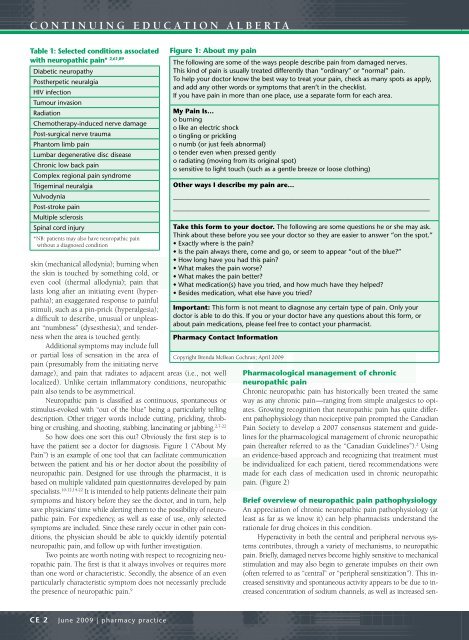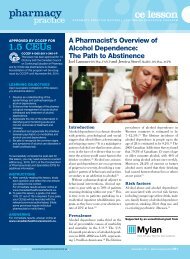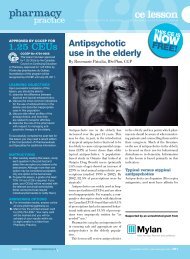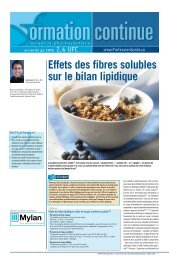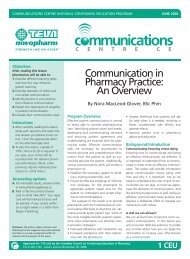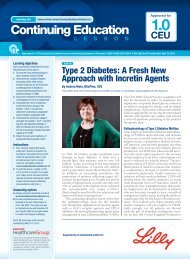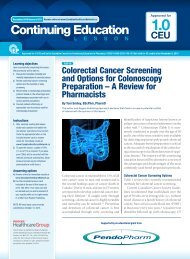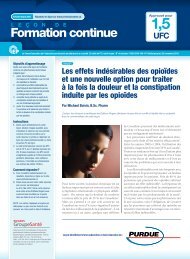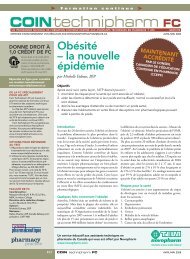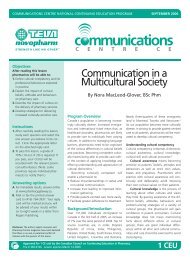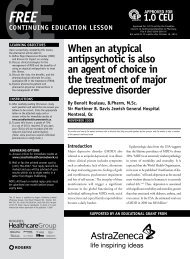The Role of the Pharmacist in the Management of Chronic ...
The Role of the Pharmacist in the Management of Chronic ...
The Role of the Pharmacist in the Management of Chronic ...
You also want an ePaper? Increase the reach of your titles
YUMPU automatically turns print PDFs into web optimized ePapers that Google loves.
C o n t i n u i n g E d u c a t i o n A l b e r t aTable 1: Selected conditions associatedwith neuropathic pa<strong>in</strong>* 2,61,89Diabetic neuropathyPos<strong>the</strong>rpetic neuralgiaHIV <strong>in</strong>fectionTumour <strong>in</strong>vasionRadiationChemo<strong>the</strong>rapy-<strong>in</strong>duced nerve damagePost-surgical nerve traumaPhantom limb pa<strong>in</strong>Lumbar degenerative disc disease<strong>Chronic</strong> low back pa<strong>in</strong>Complex regional pa<strong>in</strong> syndromeTrigem<strong>in</strong>al neuralgiaVulvodyniaPost-stroke pa<strong>in</strong>Multiple sclerosisSp<strong>in</strong>al cord <strong>in</strong>jury*NB: patients may also have neuropathic pa<strong>in</strong>without a diagnosed conditionsk<strong>in</strong> (mechanical allodynia); burn<strong>in</strong>g when<strong>the</strong> sk<strong>in</strong> is touched by someth<strong>in</strong>g cold, oreven cool (<strong>the</strong>rmal allodynia); pa<strong>in</strong> thatlasts long after an <strong>in</strong>itiat<strong>in</strong>g event (hyperpathia);an exaggerated response to pa<strong>in</strong>fulstimuli, such as a p<strong>in</strong>-prick (hyperalgesia);a difficult to describe, unusual or unpleasant“numbness” (dyses<strong>the</strong>sia); and tendernesswhen <strong>the</strong> area is touched gently.Additional symptoms may <strong>in</strong>clude fullor partial loss <strong>of</strong> sensation <strong>in</strong> <strong>the</strong> area <strong>of</strong>pa<strong>in</strong> (presumably from <strong>the</strong> <strong>in</strong>itiat<strong>in</strong>g nervedamage), and pa<strong>in</strong> that radiates to adjacent areas (i.e., not welllocalized). Unlike certa<strong>in</strong> <strong>in</strong>flammatory conditions, neuropathicpa<strong>in</strong> also tends to be asymmetrical.Neuropathic pa<strong>in</strong> is classified as cont<strong>in</strong>uous, spontaneous orstimulus-evoked with “out <strong>of</strong> <strong>the</strong> blue” be<strong>in</strong>g a particularly tell<strong>in</strong>gdescription. O<strong>the</strong>r trigger words <strong>in</strong>clude cutt<strong>in</strong>g, prickl<strong>in</strong>g, throbb<strong>in</strong>gor crush<strong>in</strong>g, and shoot<strong>in</strong>g, stabb<strong>in</strong>g, lanc<strong>in</strong>at<strong>in</strong>g or jabb<strong>in</strong>g. 2,7-22So how does one sort this out? Obviously <strong>the</strong> first step is tohave <strong>the</strong> patient see a doctor for diagnosis. Figure 1 (“About MyPa<strong>in</strong>”) is an example <strong>of</strong> one tool that can facilitate communicationbetween <strong>the</strong> patient and his or her doctor about <strong>the</strong> possibility <strong>of</strong>neuropathic pa<strong>in</strong>. Designed for use through <strong>the</strong> pharmacist, it isbased on multiple validated pa<strong>in</strong> questionnaires developed by pa<strong>in</strong>specialists. 10-12,14-22 It is <strong>in</strong>tended to help patients del<strong>in</strong>eate <strong>the</strong>ir pa<strong>in</strong>symptoms and history before <strong>the</strong>y see <strong>the</strong> doctor, and <strong>in</strong> turn, helpsave physicians’ time while alert<strong>in</strong>g <strong>the</strong>m to <strong>the</strong> possibility <strong>of</strong> neuropathicpa<strong>in</strong>. For expediency, as well as ease <strong>of</strong> use, only selectedsymptoms are <strong>in</strong>cluded. S<strong>in</strong>ce <strong>the</strong>se rarely occur <strong>in</strong> o<strong>the</strong>r pa<strong>in</strong> conditions,<strong>the</strong> physician should be able to quickly identify potentialneuropathic pa<strong>in</strong>, and follow up with fur<strong>the</strong>r <strong>in</strong>vestigation.Two po<strong>in</strong>ts are worth not<strong>in</strong>g with respect to recogniz<strong>in</strong>g neuropathicpa<strong>in</strong>. <strong>The</strong> first is that it always <strong>in</strong>volves or requires morethan one word or characteristic. Secondly, <strong>the</strong> absence <strong>of</strong> an evenparticularly characteristic symptom does not necessarily preclude<strong>the</strong> presence <strong>of</strong> neuropathic pa<strong>in</strong>. 9Figure 1: About my pa<strong>in</strong><strong>The</strong> follow<strong>in</strong>g are some <strong>of</strong> <strong>the</strong> ways people describe pa<strong>in</strong> from damaged nerves.This k<strong>in</strong>d <strong>of</strong> pa<strong>in</strong> is usually treated differently than “ord<strong>in</strong>ary” or “normal” pa<strong>in</strong>.To help your doctor know <strong>the</strong> best way to treat your pa<strong>in</strong>, check as many spots as apply,and add any o<strong>the</strong>r words or symptoms that aren’t <strong>in</strong> <strong>the</strong> checklist.If you have pa<strong>in</strong> <strong>in</strong> more than one place, use a separate form for each area.My Pa<strong>in</strong> Is…oburn<strong>in</strong>golike an electric shockot<strong>in</strong>gl<strong>in</strong>g or prickl<strong>in</strong>gonumb (or just feels abnormal)otender even when pressed gentlyoradiat<strong>in</strong>g (mov<strong>in</strong>g from its orig<strong>in</strong>al spot)osensitive to light touch (such as a gentle breeze or loose cloth<strong>in</strong>g)O<strong>the</strong>r ways I describe my pa<strong>in</strong> are…__________________________________________________________________________________________________________________________________________Take this form to your doctor. <strong>The</strong> follow<strong>in</strong>g are some questions he or she may ask.Th<strong>in</strong>k about <strong>the</strong>se before you see your doctor so <strong>the</strong>y are easier to answer “on <strong>the</strong> spot.”• Exactly where is <strong>the</strong> pa<strong>in</strong>?• Is <strong>the</strong> pa<strong>in</strong> always <strong>the</strong>re, come and go, or seem to appear “out <strong>of</strong> <strong>the</strong> blue?”• How long have you had this pa<strong>in</strong>?• What makes <strong>the</strong> pa<strong>in</strong> worse?• What makes <strong>the</strong> pa<strong>in</strong> better?• What medication(s) have you tried, and how much have <strong>the</strong>y helped?• Besides medication, what else have you tried?Important: This form is not meant to diagnose any certa<strong>in</strong> type <strong>of</strong> pa<strong>in</strong>. Only yourdoctor is able to do this. If you or your doctor have any questions about this form, orabout pa<strong>in</strong> medications, please feel free to contact your pharmacist.Pharmacy Contact InformationCopyright Brenda McBean Cochran; April 2009Pharmacological management <strong>of</strong> chronicneuropathic pa<strong>in</strong><strong>Chronic</strong> neuropathic pa<strong>in</strong> has historically been treated <strong>the</strong> sameway as any chronic pa<strong>in</strong>—rang<strong>in</strong>g from simple analgesics to opiates.Grow<strong>in</strong>g recognition that neuropathic pa<strong>in</strong> has quite differentpathophysiology than nociceptive pa<strong>in</strong> prompted <strong>the</strong> CanadianPa<strong>in</strong> Society to develop a 2007 consensus statement and guidel<strong>in</strong>esfor <strong>the</strong> pharmacological management <strong>of</strong> chronic neuropathicpa<strong>in</strong> (hereafter referred to as <strong>the</strong> “Canadian Guidel<strong>in</strong>es”). 2 Us<strong>in</strong>gan evidence-based approach and recogniz<strong>in</strong>g that treatment mustbe <strong>in</strong>dividualized for each patient, tiered recommendations weremade for each class <strong>of</strong> medication used <strong>in</strong> chronic neuropathicpa<strong>in</strong>. (Figure 2)Brief overview <strong>of</strong> neuropathic pa<strong>in</strong> pathophysiologyAn appreciation <strong>of</strong> chronic neuropathic pa<strong>in</strong> pathophysiology (atleast as far as we know it) can help pharmacists understand <strong>the</strong>rationale for drug choices <strong>in</strong> this condition.Hyperactivity <strong>in</strong> both <strong>the</strong> central and peripheral nervous systemscontributes, through a variety <strong>of</strong> mechanisms, to neuropathicpa<strong>in</strong>. Briefly, damaged nerves become highly sensitive to mechanicalstimulation and may also beg<strong>in</strong> to generate impulses on <strong>the</strong>ir own(<strong>of</strong>ten referred to as “central” or “peripheral sensitization”). This <strong>in</strong>creasedsensitivity and spontaneous activity appears to be due to <strong>in</strong>creasedconcentration <strong>of</strong> sodium channels, as well as <strong>in</strong>creased sen-CE 2June 2009 | pharmacy practice


